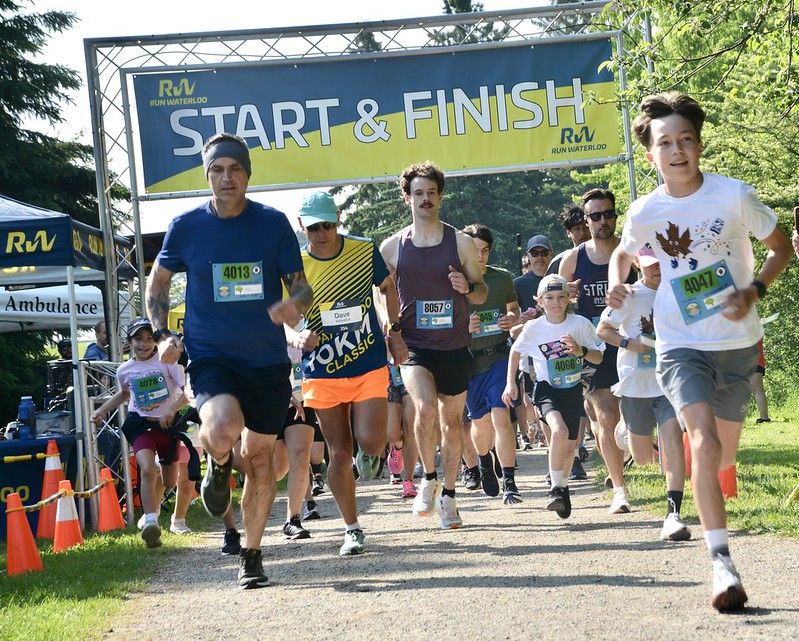Oh hey, I’m back! It’s been a while. My hiatus from writing didn’t coincide with a break from reading though, and I have accumulated a number of tidbits and interesting thoughts on training and performance to bring to you in 2019! No promises on the frequency of the articles, but I shall do my best.
Today, we’re starting with one we all need to know about: the warmup.
It’s something I’ve written about before- both in terms of cool additions that you really shouldn’t implement (such as here), how a warmup doesn’t literally mean warming up and what we’re actually after (glycogen mobilization and increase in blood flow to our running muscles), and even how it relates to carbohydrate ingestion (here).
Warmup Duration
One thing I get asked about often enough at H+P is why my warmup protocols vary so drastically from  distance to distance. For instance, for 5K and under, the warmup is longer with drills. For the marathon, the warmup is just long enough to make sure your shoes won’t come untied and to keep the mind relaxed.
distance to distance. For instance, for 5K and under, the warmup is longer with drills. For the marathon, the warmup is just long enough to make sure your shoes won’t come untied and to keep the mind relaxed.
But is this the actual best piece of advice? From a physiological standpoint, there is a good rationale behind these different warm up designs. When we want to run our best in a shorter event, in theory you want to make sure your blood is swimming with glucose from mobilized glycogen (chains of glucose stored in your muscles). You also want a decrease in insulin to make sure those carbs stay accessible. You also want to make sure the blood vessels in the musculature most heavily used during running are dilated and ready to receive oxygen carrying blood.
You also want to make sure your musculature is primed to contract in an economical way. As I have written about before, running performance is not solely predicted by your aerobic fitness, but also by how economically you use the oxygen you bring in. Running economy can be enhanced acutely with a warmup by doing things such as strides and drills (priming the muscles to contract more efficiently), and NOT statically stretching (which has the opposite effect, decreasing running economy).
Study: Does Warming-Up Make a Difference?
But is this consistent with what we see in the research? Let’s check out this recent 2018 study.
In this study, participants underwent 4 different warmup protocols, and were then tested at 90% of their max effort and timed to exhaustion.
The warmup options included:
- No warmup
- Running 15minutes at 60% of their V02max
- Running 15minutes at 70% of their V02max
- Running 15minutes at 80% of their V02max
Time to exhaustion at 90% of their V02max and temperature of the vastus lateralis (part of the quads) was tested.
Results:
Despite the different intensities (or no warmup at all), time to exhaustion was the same across all the trials – as was the change in the temperature in quad muscle! In other words, if you’re running at 90% of your V02max, and you only have 15 minutes to warm up, what you do will likely not make a major difference.
So what does this show us? Well, all of that work to prime muscles, mobilize sugar, and open up blood vessels likely does not matter that much when it comes to sub maximal running- or at least matters less the further away from maximal you get.
It’s also important to note that this study, like other studies, chose to keep things simple to allow for more specific and concrete conclusions. How would that time to exhaustion change with drills, a 30 minute warmup or adding strides? From this one study alone, we don’t know.
Physiology of Warmups
It was great having performance as the main outcome measure in this study since that’s what we care about the most in the end. But what was the physiological reason for what they saw?
The temperature measurement was a very limited – albeit interesting – attempt at explaining some of the physiology behind why the warmups didn’t impact performance. That being said, it is consistent with what I have seen in studies looking at completely different parameters in a similar way. A good example is different carb ingesting protocols (as I wrote about here). We try our best to consume our carbs pre-race at the perfect interval to avoid a sugar-storing insulin spike, but as studies have shown, our bodies adapt very quickly once we start running and performance doesn’t suffer as much as we’d think.
Another caveat to all of this is perceived exertion. As we have seen time and time again, the brain plays a major roll in our performance (as I have written about here). Logically, if your warmup helps to prime the mind for pain, there’s a good chance you will perform better, especially in middle distance races such as a 5K.
Weigh the Risks
That being said, it is important to understands the “risks” of a longer warmup. Is the potential mind priming, and very transient change in blood sugar, insulin, and muscle priming from a 30minute WU and strides worth it before a race that will take you hours, such as a marathon? Why risk losing your valuable glycogen and fatigue your limited muscle fibre endurance? You will need every ounce of these things to get from 40- 42.2K at your best.
Take Home
The way I balance these give-and-takes it is by looking at each race as a continuum of the benefits of priming and the risks of muscle fibre fatigue and glycogen depletion. The shorter the race, the longer the warmup and the more drills we add. The longer the race, the more we reduce that warmup jog and cut out strides and drills.
All of these decisions also always depend on the athlete. Are you treating the race as a workout? Are you well trained? Are you going to ease into your pacing, or do you know you’ll have to hammer right off the bat to catch a pack from the start (i.e. time trial vs. XC race)? The decision is always multifactorial.
Sample Warmups:
So, using this information, for a competitive, well-trained athlete looking to max out their 5K and marathon performance, this is how their warmups may look:
5K
~50 minutes before the start, 35 minutes easy running.
A few sets of running ABCs, depending on the athlete.
5x50m strides, jog back to start.
Marathon:
Shuffle 1-2K, make sure your shoes won’t fall off, sit on the ground until the race starts.
Hopefully this helps make your warmup decisions more clear. Do enough to prime the mind, and to make sure you’re fresh enough to respond to the first 1-2K of a race plan. From that point on, let your physiology adapt to the effort and carry you through the rest of the race!






